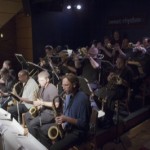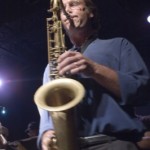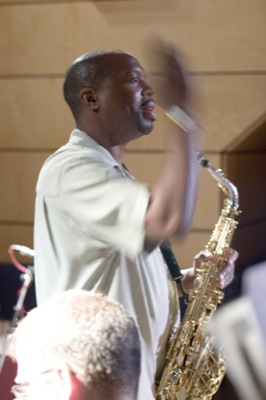 Founded by saxophonists and composers CRAIG BAILEY (Ray Charles, Tom Harrell, Art Blakey) and TIM ARMACOST (Kenny Barron, Roy Hargrove, Billy Hart) the 16-piece BROOKLYN BIG BAND performs new music written and arranged by its members. Their concerts are a thrilling mix of spontaneous composition, rock-steady rhythm, and tight ensemble work. The band has performed regularly at venues including Sweet Rhythm, Caviar, Miles Cafe, Po’k Knockers and Brooklyn’s Tea Lounge. BBB has also performed famed producer Teo Macero’s music at Birdland, (which became one of the final performances attended by Mr. Macero) and held a 14-month engagement at Cafe Iguana in Times Square. This dynamic ensemble has been profiled on New York’s CW network, WPIX-TV (Channel 11), and featured extensively on Fox News Channel’s FOX & Friends.
Founded by saxophonists and composers CRAIG BAILEY (Ray Charles, Tom Harrell, Art Blakey) and TIM ARMACOST (Kenny Barron, Roy Hargrove, Billy Hart) the 16-piece BROOKLYN BIG BAND performs new music written and arranged by its members. Their concerts are a thrilling mix of spontaneous composition, rock-steady rhythm, and tight ensemble work. The band has performed regularly at venues including Sweet Rhythm, Caviar, Miles Cafe, Po’k Knockers and Brooklyn’s Tea Lounge. BBB has also performed famed producer Teo Macero’s music at Birdland, (which became one of the final performances attended by Mr. Macero) and held a 14-month engagement at Cafe Iguana in Times Square. This dynamic ensemble has been profiled on New York’s CW network, WPIX-TV (Channel 11), and featured extensively on Fox News Channel’s FOX & Friends.
 After landing in New York in 1993, Tim Armacost quickly established his presence as a leader, releasing his first two albums, “Fire” (Concord) and “Live at Smalls” (Double Time) to critical acclaim. His hard hitting third release, “The Wishing Well,” (Double Time) announced the arrival of Armacost’s working unit, featuring Bruce Barth, Ray Drummond, and Billy Hart. The group completed six successful tours in Europe and Asia and followed up with an inspired second recording, “Brightly Dark.” (Satchmo Records). Armacost’s current release, “Rhythm and Transformation,” (ArtistShare 0064) features the quartet augmented by Ray Spiegel playing Tabla, and the great Eddie Henderson on trumpet. Working with his quartet, the cooperative group Hornz in the Hood with fellow saxophonists Craig Handy and Ravi Coltrane, Ray Drummond’s “Excursion Band,” and co-leading the Brooklyn Big Band with Craig Bailey, Armacost is now seriously in the mix.
After landing in New York in 1993, Tim Armacost quickly established his presence as a leader, releasing his first two albums, “Fire” (Concord) and “Live at Smalls” (Double Time) to critical acclaim. His hard hitting third release, “The Wishing Well,” (Double Time) announced the arrival of Armacost’s working unit, featuring Bruce Barth, Ray Drummond, and Billy Hart. The group completed six successful tours in Europe and Asia and followed up with an inspired second recording, “Brightly Dark.” (Satchmo Records). Armacost’s current release, “Rhythm and Transformation,” (ArtistShare 0064) features the quartet augmented by Ray Spiegel playing Tabla, and the great Eddie Henderson on trumpet. Working with his quartet, the cooperative group Hornz in the Hood with fellow saxophonists Craig Handy and Ravi Coltrane, Ray Drummond’s “Excursion Band,” and co-leading the Brooklyn Big Band with Craig Bailey, Armacost is now seriously in the mix.
Tim Armacost’s career is already distinguished by performance and recording credits alongside the likes of Al Foster, Jimmy Cobb, Kenny Barron, Tom Harrell, Billy Hart, Victor Lewis, Jeff “Tain” Watts, Peter Erskine, Ray Drummond, Roy Hargrove, Paquito D’Rivera, Claudio Roditi, Bruce Barth, Dave Kikoski, Don Friedman, Lonnie Plaxico, Robin Eubanks, Charlie Shoemake, Pete Christlieb, Randy Brecker, Akira Tana, Valery Ponomarev, the Maria Schneider Orchestra, and the David Murray Big Band. He has toured throughout East and West Europe, Japan, India, Australia, China and the United States.
Armacost began his musical training on clarinet in Tokyo at the age of eight. By sixteen he had switched to tenor saxophone, and was working in big bands around Washington. The turning point into a jazz career came back in LA at eighteen, where Armacost met his two primary teachers, Bobby Bradford and Charlie Shoemake. Armacost graduated Magna Cum Laude from Pomona College with a major in Asian Studies in 1985. After establishing himself on the jazz scene in Amsterdam, he became the head of the Sweelinck Conservatory’s saxophone department. Completing seven years of extensive performing, teaching, and recording experience in Europe, Armacost headed for India where he had the good fortune to become a student of the tabla master Vijay Ateet where he explored the rich rhythmic tradition of Hindustani classical music.
Throughout twenty-five years of frequent traveling to Japan, Tim Armacost has developed a deep and special relationship with its people. He is a fluent speaker of Japanese, which he studied as an exchange student at Waseda University, and is an active student of Japanese culture and religion. His performances there have included such great musicians as Terumasa and Motohiko Hino, Fumio Karashima, Nobuyoshi Ino, Fumio Itabashi, Shingo Okudaira, Benisuke Sakai, Kiyoto Fujiwara, and Yutaka Shiina.
 Craig Bailey’s interest in music began at the age of eight when he learned how to play the recorder with a small group of classmates. Following that, he became a part of the All City Boys Choir in his hometown of Cincinnati, Ohio. He enrolled in the beginning band program in junior high and took up the clarinet, saxophone and flute, perfecting his skills in playing all three instruments in high school, then in college.
Craig Bailey’s interest in music began at the age of eight when he learned how to play the recorder with a small group of classmates. Following that, he became a part of the All City Boys Choir in his hometown of Cincinnati, Ohio. He enrolled in the beginning band program in junior high and took up the clarinet, saxophone and flute, perfecting his skills in playing all three instruments in high school, then in college.
Inspired after earning his undergraduate degree from the University of Miami, he headed to New York City in 1985. As a young artist in New York, Bailey worked with drummer Charli Persip’s Superband. Here, Bailey made many musical contacts and heard some of the jazz world’s finest veterans and young lions. After he joined the world renowned group of Panama Francis and his Savoy Sultans, Craig learned more about traditional swing music. With Francis’ group, he traveled to Europe for the first time experiencing the great appreciation of the European audiences.
After playing with the Savoy Sultans for two years, Bailey landed an audition with Ray Charles and became the lead alto saxophonist (1988-2004). While working with Ray Charles, Bailey worked with other artists such as the TanaReid Quintet, co-led by bassist Rufus Reid and drummer Akira Tana (1990-1998); Bobby Watson’s Tailor Made Big Band (1993-1996); and the Tom Harrell Big Band (1999-2001) to name a few. He developed his small group writing and playing style while apprenticing with the artists mentioned and others. He draws upon the wealth of experiences from having played with some of the world’s greatest composers and arrangers, as well as the experience of world travels and the exposure to all ranges of musical genres.
For Bailey, one of the most musically rewarding aspects is to be a part of bringing to life a piece of music composed and/or arranged by the artist or arranger/composer for whom he’s playing. Performing great works of music has led him to his own arranging and composing.
His debut CD “A New Journey” met with critical acclaim, and is referenced in “The Encyclopedia of Jazz” (revised by Ira Gitler). His second release “Brooklyn” was reviewed in Jazztimes by Ron Wynn who noted, “There are no stilted performances or ragged edges that repeatedly surface on blowing sessions or hired-gun dates. This band has played these songs long enough to have a polish and precision, which is refreshing. The group also brings a sense of purpose to Bailey’s compositions . . . and his impact is sizeable on Brooklyn.”
